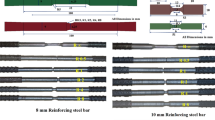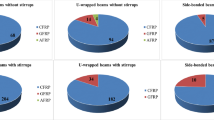Abstract
The mechanical response of rock bridges plays a key role in the stability of concrete and rock structures. In particular, the tensile failure of non-persistent discontinuities can result in their coalescence and the failure of rock or concrete engineering structures. The effect of non-persistent joint parameters on rock structures’ failure under tensile mode has not been investigated by many researchers yet. Many non-persistent jointed Brazilian concrete discs are tested under diametral loading in this work, to study the influence of joint spacing, joint continuity factor, loading direction with regard to joint angle, and bridge angle on their tensile behavior. Heuristic methods like artificial neural network (ANN), adaptive neuro-fuzzy inference system (ANFIS) and a combination of ANFIS with particle swarm optimization (ANN-PSO) and genetic algorithm (ANFIS-GA) were adopted to explore the relationship between tensile strength and stiffness as the response and non-persistent joint parameters as input parameters. The results revealed that all the applied intelligent methods have the ability to predict tensile strength of non-persistent jointed discs, and their outputs are consistent with laboratory results; however, the ANN approach had the best performance with R2 = 0.966, RMSE = 0.176. In addition, parametric analysis of the proposed model showed that the model is highly sensitive to joint continuity factor and loading direction, while it is sensitive to joint spacing and bridge angle.














Similar content being viewed by others
Change history
01 September 2022
A Correction to this paper has been published: https://doi.org/10.1007/s10064-022-02892-9
Abbreviations
- d :
-
Joint spacing (cm)
- γ :
-
Bridge angle (degree)
- β :
-
Loading direction with respect to joint angle (degree)
- L j :
-
Joint length (cm)
- L j :
-
Rock bridge length (cm)
- k :
-
Joint continuity factor (\(k=\frac{{L}_{j}}{{L}_{j}+{L}_{r}}\))
- σ 1 :
-
Major principal stress
- UCS:
-
Unconfined compressive strength
- E :
-
Young's modulus (GPa)
- σt :
-
Tensile strength (MPa)
- ν:
-
Poisson's ratio
- MPSA :
-
Multiple parametric sensitivity analysis
- \({f}_{h}\) :
-
Objective Function
- \({\delta }_{h}\) :
-
Independent relative importance of each parameter
- \({\varvec{\gamma}}\) :
-
Sum of independent relative importance of each parameter
- ANN :
-
Artificial neural network
- ANFIS :
-
Adaptive neuro-fuzzy inference system
- PSO :
-
Particle swarm optimization
- GA :
-
Genetic algorithm
References
Armaghani DJ, Momeni E, Abad SVANK et al (2015) Feasibility of ANFIS model for prediction of ground vibrations resulting from quarry blasting. Environ Earth Sci 74:2845–2860. https://doi.org/10.1007/s12665-015-4305-y
Asadizadeh M, Hossaini MF (2016) Predicting rock mass deformation modulus by artificial intelligence approach based on dilatometer tests. Arab J Geosci 9:96. https://doi.org/10.1007/s12517-015-2189-5
Asadizadeh M, Hossaini MF, Moosavi M et al (2019) Mechanical characterisation of jointed rock-like material with non-persistent rough joints subjected to uniaxial compression. Eng Geol 260:105224. https://doi.org/10.1016/j.enggeo.2019.105224
Asadizadeh M, Majdi A (2019) Developing new Adaptive Neuro-Fuzzy Inference Systems to predict granular soil groutability. International J Mining Geo-Eng 53:133–142. https://doi.org/10.22059/IJMGE.2018.255209.594728
Asadizadeh M, Moosavi M, Hossaini MF (2018a) Investigation of mechanical behaviour of non-persistent jointed blocks under uniaxial compression. Geomech Eng 14:29–42. https://doi.org/10.12989/gae.2018a.14.1.029
Asadizadeh M, Moosavi M, Hossaini MF, Masoumi H (2018b) Shear Strength and Cracking Process of Non-persistent Jointed Rocks: An Extensive Experimental Investigation. Rock Mech Rock Eng 51:415–428. https://doi.org/10.1007/s00603-017-1328-6
Asadizadeh M, Tavakoli H, Rahmannejad R, Mehinrad A (2010) Effect of anisotropy and confining pressure ratio on rock mass deformation modulus at Bakhtiary dam site (Iran). In: ISRM International Symposium - 6th Asian Rock Mechanics Symposium, ARMS 2010. Int Soc Rock Mech Rock Eng
Aydin M, Karakuzu C, Uçar M et al (2013) Prediction of surface roughness and cutting zone temperature in dry turning processes of AISI304 stainless steel using ANFIS with PSO learning. Int J Adv Manuf Tech 67:957–967. https://doi.org/10.1007/s00170-012-4540-2
Azarfar B, Peik B, Abbasi B, Roghanchi P (2018) A discussion on numerical modeling of fault for large open pit mines. 52nd US Rock Mech/Geomech Symp
Bahaaddini M, Hagan P, Mitra R, Hebblewhite BK (2016) Numerical Study of the Mechanical Behavior of Nonpersistent Jointed Rock Masses. Int J Geomech 16:4015035. https://doi.org/10.1061/(ASCE)GM.1943-5622.0000510
Bahaaddini M, Sharrock G, Hebblewhite BK (2013) Numerical investigation of the effect of joint geometrical parameters on the mechanical properties of a non-persistent jointed rock mass under uniaxial compression. Comput Geotech 49:206–225. https://doi.org/10.1016/j.compgeo.2012.10.012
Barton N (1973) Review of a new shear-strength criterion for rock joints. Eng Geol 7:287–332. https://doi.org/10.1016/0013-7952(73)90013-6
Bieniawski ZT, Hawkes I (1978) Suggested Methods for Determining Tensile Strength of Rock Materials. Int J Rock Mech Min Sci 15:99–103
Brady BHG, Brown ET (2004) Rock Mechanics for underground mining. Springer, Netherlands, Dordrecht
Cheng C, Chen X, Zhang S (2016) Multi-peak deformation behavior of jointed rock mass under uniaxial compression: Insight from particle flow modeling. Eng Geol 213:25–45. https://doi.org/10.1016/j.enggeo.2016.08.010
Correa JM, Farret FA, Popov VA, Simoes MG (2005) Sensitivity Analysis of the Modeling Parameters Used in Simulation of Proton Exchange Membrane Fuel Cells. IEEE Trans Energy Convers 20:211–218. https://doi.org/10.1109/TEC.2004.842382
Feng P, Dai F, Liu Y et al (2018) Effects of strain rate on the mechanical and fracturing behaviors of rock-like specimens containing two unparallel fissures under uniaxial compression. Soil Dyn Earthq Eng 110:195–211. https://doi.org/10.1016/j.soildyn.2018.03.026
Haeri H, Sarfarazi V, Zhu Z (2016) Analysis of Crack Coalescence in Concrete Using Neural Networks. Strength Mater 48:850–861. https://doi.org/10.1007/s11223-017-9831-2
Hajihassani M, Jahed Armaghani D, Monjezi M et al (2015) Blast-induced air and ground vibration prediction: a particle swarm optimization-based artificial neural network approach. Environ Earth Sci 74:2799–2817. https://doi.org/10.1007/s12665-015-4274-1
Höglund H (2017) Tax payment default prediction using genetic algorithm-based variable selection. Expert Syst Appl 88:368–375. https://doi.org/10.1016/j.eswa.2017.07.027
Holland JH (1992) Adaptation in Natural and Artificial Systems. The MIT Press
Huang J, Asteris PG, Manafi Khajeh Pasha S et al (2020) A new auto-tuning model for predicting the rock fragmentation: a cat swarm optimization algorithm. Eng Comput. https://doi.org/10.1007/s00366-020-01207-4
Jang J-S (1993) ANFIS: adaptive-network-based fuzzy inference system. IEEE Trans Syst Man Cybern 23:665–685
Jennings JE (1970) A mathematical theory for the calculation of the stability of open cast mines. In: Symp. on Theor. Background to the Plann. of Open Pit Mines. A. A. Balkema, Johannesburg
Karimi J, Asadizadeh M, Hossaini MF et al (2021) Compressive strength of flawed cylindrical specimens subjected to axial loading. Geomech Eng 27:87–99. https://doi.org/10.12989/gae.2021.27.1.087
Lajtai EZ (1973) Fracture From Compressive Stress. Int 7 Rock .tlech Attn Sci & G¢omech Abslr 10:265–284
Lawal AI, Kwon S (2021) Application of artificial intelligence to rock mechanics: An overview. J Rock Mech Geotech Eng 13:248–266. https://doi.org/10.1016/j.jrmge.2020.05.010
Lin Q, Cao P, Meng J et al (2020) Strength and failure characteristics of jointed rock mass with double circular holes under uniaxial compression: Insights from discrete element method modelling. Theoret Appl Fract Mech 109:102692. https://doi.org/10.1016/j.tafmec.2020.102692
Luo Z, Bui X-N, Nguyen H, Moayedi H (2021) A novel artificial intelligence technique for analyzing slope stability using PSO-CA model. Eng Comput 37:533–544. https://doi.org/10.1007/s00366-019-00839-5
Mahmoodzadeh A, Mohammadi M, Ibrahim HH et al (2021) Tunnel geomechanical parameters prediction using Gaussian process regression. Mach Learn App 3:100020. https://doi.org/10.1016/j.mlwa.2021.100020
Martin A, Gayathri V, Saranya G et al (2011) A Hybrid Model for Bankruptcy prediction Using Genetic Algorithm, Fuzzy C-Means and Mars. Int J Soft Comput 2:12–24. https://doi.org/10.5121/ijsc.2011.2102
Momeni E, Nazir R, Jahed Armaghani D, Maizir H (2014) Prediction of pile bearing capacity using a hybrid genetic algorithm-based ANN. Measurement 57:122–131. https://doi.org/10.1016/j.measurement.2014.08.007
Nguyen HQ, Ly H-B, Tran VQ et al (2020) Optimization of Artificial Intelligence System by Evolutionary Algorithm for Prediction of Axial Capacity of Rectangular Concrete Filled Steel Tubes under Compression. Materials 13:1205. https://doi.org/10.3390/ma13051205
Rajabi M, Rahmannejad R, Rezaei M, Ganjalipour K (2017) Evaluation of the maximum horizontal displacement around the power station caverns using artificial neural network. Tunn Undergr Space Technol 64:51–60. https://doi.org/10.1016/J.TUST.2017.01.010
Rezaei M (2019) Forecasting the stress concentration coefficient around the mined panel using soft computing methodology. Eng Comput 35:451–466. https://doi.org/10.1007/s00366-018-0608-4
Rezaei M (2017) Feasibility of novel techniques to predict the elastic modulus of rocks based on the laboratory data. Int J Geotech Eng. https://doi.org/10.1080/19386362.2017.1397873
Rezaei M (2016) Development of an intelligent model to estimate the height of caving–fracturing zone over the longwall gobs. Neural Comput Appl. https://doi.org/10.1007/s00521-016-2809-3
Rezaei M, Asadizadeh M (2020) Journal of Mining and Environment (JME) Predicting Unconfined Compressive Strength of Intact Rock Using New Hybrid Intelligent Models. J Min Environ 11:231–246. https://doi.org/10.22044/jme.2019.8839.1774
Rivera JI, Bonilla CA (2020) Predicting soil aggregate stability using readily available soil properties and machine learning techniques. CATENA 187:104408. https://doi.org/10.1016/j.catena.2019.104408
Saberi H, Sharbati R, Farzanegan B (2022) A gradient ascent algorithm based on possibilistic fuzzy C-Means for clustering noisy data. Expert Syst Appl 191:116153. https://doi.org/10.1016/J.ESWA.2021.116153
Sarfarazi V, Hajiloo M, Ghalam EZ, Ebneabbasi P (2020) Study of tensile behavior of Y shape non-persistent joint using experimental test and numerical simulation. Comput Concr 26:565–576. https://doi.org/10.12989/cac.2020.26.6.565
Shakeri J, Asadizadeh M, Babanouri N et al (2022) The evolution of dynamic energy during drop hammer testing of Brazilian disk with non-persistent joints: An extensive experimental investigation. Theoret Appl Fract Mech 117:103162. https://doi.org/10.1016/j.tafmec.2021.103162
Shang J, West LJ, Hencher SR, Zhao Z (2018) Tensile strength of large-scale incipient rock joints: a laboratory investigation. Acta Geotech 13:869–886. https://doi.org/10.1007/s11440-017-0620-7
Sharbati R, Amindavar H, Sharbati R et al (2022) Optimized Cauchy-Gaussian Blend Model for Stochastic-Parametric Simulation of Seismic Ground Motions. Prevention and Treatment of Natural Disasters 1:38–49. https://doi.org/10.54963/PTND.V1I1.62
Shojaeian A, Asadizadeh M (2020) Prediction of surface tension of the binary mixtures containing ionic liquid using heuristic approaches; an input parameters investigation. J Mol Liq 298:111976. https://doi.org/10.1016/j.molliq.2019.111976
Tsuruta R, Utsuki S, Nakaya M (2019) Development of a System for Automatic Evaluation of the Geological Conditions of Tunnel Faces Using Artificial Intelligence and Application to a Construction Site. IAEG/AEG Annual Meeting Proceedings, San Francisco, California, 2018 -, vol 4. Springer International Publishing, Cham, pp 49–55
Vaziri MR, Tavakoli H, Bahaaddini M (2022) Statistical analysis on the mechanical behaviour of non-persistent jointed rock masses using combined DEM and DFN. Bull Eng Geol Env 81:177. https://doi.org/10.1007/s10064-022-02674-3
Victoire TAA, Jeyakumar AE (2004) Hybrid PSO–SQP for economic dispatch with valve-point effect. Electr Power Syst Res 71:51–59. https://doi.org/10.1016/j.epsr.2003.12.017
Wang T-T, Huang T-H (2009) A constitutive model for the deformation of a rock mass containing sets of ubiquitous joints. Int J Rock Mech Min Sci 46:521–530. https://doi.org/10.1016/j.ijrmms.2008.09.011
Wittke W (2014) Rock Mechanics Based on an Anisotropic Jointed Rock Model. Wilhelm Ernst & Sohn, Berlin
Yang S-Q, Chen M, Huang Y-H et al (2020) An experimental study on fracture evolution mechanism of a non-persistent jointed rock mass with various anchorage effects by DSCM, AE and X-ray CT observations. Int J Rock Mech Min Sci 134:104469. https://doi.org/10.1016/j.ijrmms.2020.104469
Yang XX, Kulatilake PHSW, Chen X et al (2016) Particle Flow Modeling of Rock Blocks with Nonpersistent Open Joints under Uniaxial Compression. Int J Geomech 16:04016020. https://doi.org/10.1061/(ASCE)GM.1943-5622.0000649
Author information
Authors and Affiliations
Corresponding author
Additional information
The original online version of this article was revised: Originally, there is a mistake in the affiliation of the third author. Taghi sherizadeh has just one affiliation as follows:
Department of Mining and Nuclear Engineering, Missouri, University of Science and Technology, Rolla, MT 65409, USA.
Rights and permissions
Springer Nature or its licensor holds exclusive rights to this article under a publishing agreement with the author(s) or other rightsholder(s); author self-archiving of the accepted manuscript version of this article is solely governed by the terms of such publishing agreement and applicable law.
About this article
Cite this article
Asadizadeh, M., Babanouri, N. & Sherizadeh, T. A heuristic approach to predict the tensile strength of a non-persistent jointed Brazilian disc under diametral loading. Bull Eng Geol Environ 81, 364 (2022). https://doi.org/10.1007/s10064-022-02869-8
Received:
Accepted:
Published:
DOI: https://doi.org/10.1007/s10064-022-02869-8




